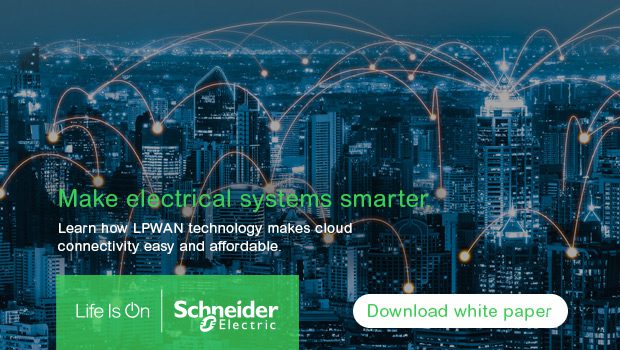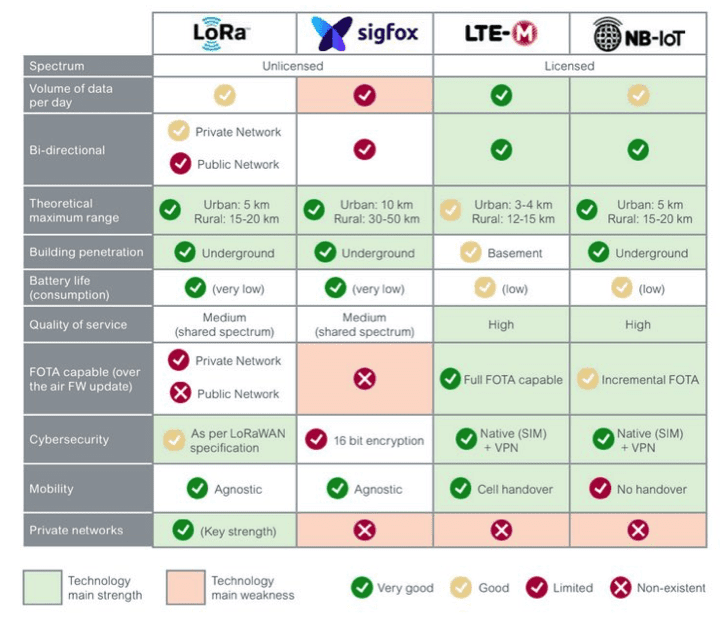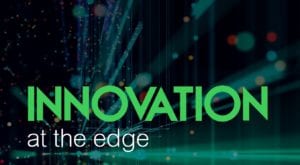A low-power wide-area network, or LPWAN, is a wireless technology that allows long-range communications at low data bit rates. LPWAN technologies are often used to link connected devices within electrical distribution equipment to the cloud. LPWAN has grown significantly in recent years. According to MarketsandMarkets, since 2016, LPWAN has experienced a Compound Annual Growth Rate (CAGR) of nearly 90% (and is projected to reach an estimated $24.46 Billion USD by the end of this year).
By deploying LPWAN technology, in conjunction with the installation of “smart” electrical distribution devices in buildings, capabilities like remote monitoring, data analysis, and even predictive maintenance become possible.

Sorting through the possible electrical distribution system LPWAN options
When consulting engineers specify LPWAN solutions, they have quite a few choices to pick from. Although the field is populated with a diverse group of many players, four global technology providers have emerged as dominant: LTE-M, NB-IoT, LoraWan, and SigFox.
How should a consulting engineer determine which LPWAN technology is the most appropriate? The answer will depend upon a list of variables that include end-user cost sensitivity, end-user geographical location, the data rate and range required, and power consumption of associated hardware devices deployed.
When comparing LPWAN technologies, consulting engineers should consider four important differences:
- Licensed vs. unlicensed status – LTE-M and NB-IoT are using “licensed” radio frequency spectrum resources. Telcos proposing this technology pay a fee to local authority and they can benefit from higher data capacity rates and a higher quality of service. Therefore, they can easily support control/command applications and “over-the- air” firmware upgrades. On the other hand, LoraWan and SigFox are operating in an “unlicensed” spectrum. They utilize a free of charge frequency bands to support a range of applications and vie for space with other users within that available bandwidth. The quantity of data that can be sent across the “free” spectrum is more limited. In fact, fair use is imposed by the regulations to allow multiple applications coexistence Thus, the unlicensed technologies are more appropriate for users who require support for only very basic, low-power battery-operated sensors, for example.
- Public vs. private network – LTE-M and NB-IoT operate within public networks, e.g., shared among multiple customers. Sigfox, although an unlicensed technology, also relies on a public network (note that Sigfox is both the name of the technology and the Telco operating a public network). LoraWan, however, can operate within either a public or private network. Within a private network, users can avoid paying recurrent connectivity fees to a Telecom operator and can also benefit from operating in a geographical area where no public network is available.

- Communication range and volume of data – Communication range is an important factor in determining where sensors and devices can be located in a building (e.g., underground, in a basement, or on an elevated floor). Base station density in a cellular network also plays a factor in helping to define level-of-service availability. Also note that amount of transmitted data impacts power consumption. The more information that is transmitted, the more energy is required. High-energy consumption impacts the product lifecycle of battery-operated devices. LTE-M offers higher data rates when compared to NB-IoT. However, NB-IoT offers a longer communication range with the same power signal output level (thus it consumes less power while offering a similar communication range). Hardware and power consumption costs are higher with LTE-M and NB-IoT than with the “unlicensed” offerings. Among unlicensed offerings, SigFox offers a longer range than LoraWan, but it is more limited in the quantity of data it can send on a given day. Sigfox is more suited to supporting basic low-power battery-operated sensors while LoraWan is a better fit for facilitating the energy monitoring and alarming of an electric panelboard, for instance.
- Geographical location – Some of these technologies are more prevalent in some geographies more than others. For instance, in Europe, LoraWan is a more mature technology where roaming capabilities are well established. LTE-M and/or NB-IoT are more global, but deployment is still in progress in many countries and roaming agreements involving Telcos are still under discussion. NB-IoT is currently popular in China and LTE-M is a prominent early front-runner in the Americas.
For more information
The LPWAN technology ultimately selected should depend upon which specific use cases and applications are targeted. Users will need to determine which of the strengths of each technology best aligns with their business need. To learn more about how LPWAN can enable smart electrical distribution systems, download the new Schneider Electric white paper, “How LPWAN Will Enable Massive Electrical Distribution Equipment Cloud Connectivity.” This year, in a few selected countries, Schneider Electric is also launching PrismaSeT Active, its first LPWAN-enabled switchboard. This switchboard will be a revolution to enable any customer, in any commercial building, to not only give their electrical distribution a voice, but also optimize maintenance, save energy, and increase uptime.


